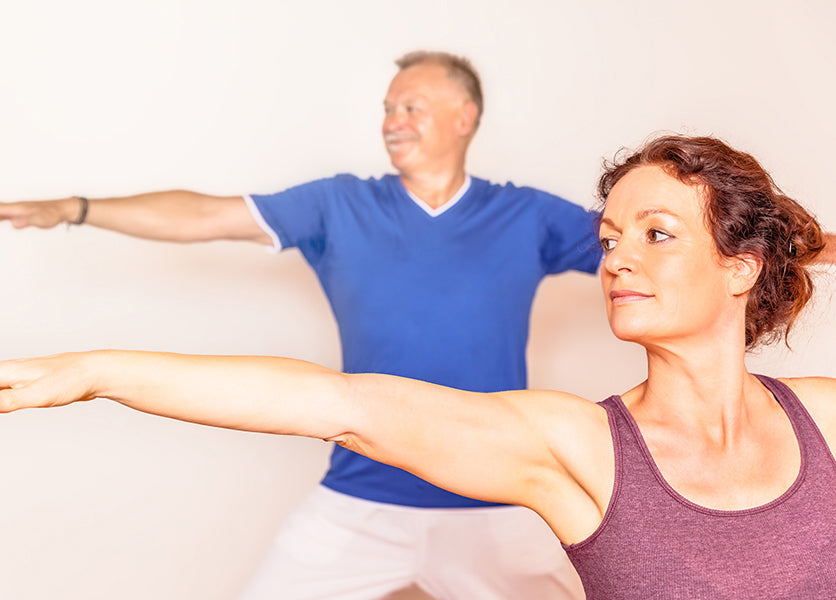
Yoga
Debra MurrayDiscover the Benefits of Yoga
Yoga may be an exercise you have only learned about in the past several years, but its actually been practiced for more than 5,000 years. Yoga is the complete workout. It not only tones muscles and burns calories, but teaches proper breathing and relaxes the mind.
There are many forms of yoga. Over the centuries over a 100 different forms have developed. The most popular and widely taught are:
- Hatha- The form most often associated with yoga, it combines a series of basic movements with breathing.
- Vinyasa- A series of poses that flow smoothly into one another.
- Power- A faster, higher-intensity practice that builds muscle.
- Ashtanga- A series of poses, combined with a special breathing technique.
- Bikram- Also known as "hot yoga," it's a series of 26 challenging poses performed in a room heated to a high temperature.
- Iyengar- A type of yoga that uses props like blocks, straps, and chairs to help you move your body into the proper alignment.
The intensity of a yoga workout depends on which form of yoga is followed. Techniques like Hatha and Iyengar yoga are gentle and slow. Bikram and power yoga are faster and more challenging. It may be best to try different types and find the one which works best you.
Practicing yoga can help you physically in these key areas:
- Core: There are yoga poses to target just about every core muscle
- Arms: With yoga, you don't build arm strength with free weights or machines, but with the weight of your own body.
- Legs: Yoga poses work all sides of the legs, including your quadriceps, hips, and thighs.
- Glutes: Yoga squats, bridges, and warrior poses involve deep knee bends, which give you a more sculpted rear.
- Back: Many poses give back muscles a good stretch. Research finds yoga is good for relieving a sore back.
- Flexibility: Yoga poses stretch muscles and increase range of motion. With regular practice, flexibility improves.
- Strength: Regular practice will strengthen the muscles of your arms, back, legs, and core.
- Low-Impact: Yoga will give a full-body workout, but won't put any impact on joints.
People of all ages and fitness levels can do the most basic yoga poses and stretches. As you become more familiar with the practice, you will find yourself moving on to more difficult poses. There are many books and instructional videos on yoga, so you can practice at home. But for the beginner it may be best to attend a few classes first to learn the proper way to perform each pose so you can get the full benefit and learn how not to hurt yourself.
Chances are, there's a type of yoga that suits your needs and fitness level. It's a great choice if you want a holistic approach to mind and body strength. Yoga has been found to help with:
- Mental health
- Back pain
- Heart disease
- Asthma
- Arthritis
- Insomnia
- Memory
Can I practice Yoga If I Have a Health Condition?
Yoga is a great activity if you have diabetes, high blood pressure, high cholesterol, or heart disease. It gives you strength, flexibility, and mind-body awareness. You should also add an aerobic activity, such as walking or biking if you're not doing a fast-moving type of yoga.
If you have high blood pressure, diabetes, or heart problems, ask your doctor first about conditions which may require you to avoid certain positions, such as being upside down. You don’t have to give up yoga altogether, just know what the limitations are. There is still so much you can gain from practicing yoga. A very gentle program of yoga, coupled with a light aerobic activity like walking or swimming, may be the best way to start.
Do you have arthritis? Yoga can help you stay flexible and strong without putting added stress on your joints. The gentle movements can be very helpful for those with arthritis. Exercise is actually a good way to prevent or slow down osteoarthritis.
Beginning an exercise routine is often daunting. The gentle movements of yoga may be the solution you are looking for to get a healthier body and mind.
Source:
http://www.webmd.com/fitness-exercise/a-z/yoga-workouts
